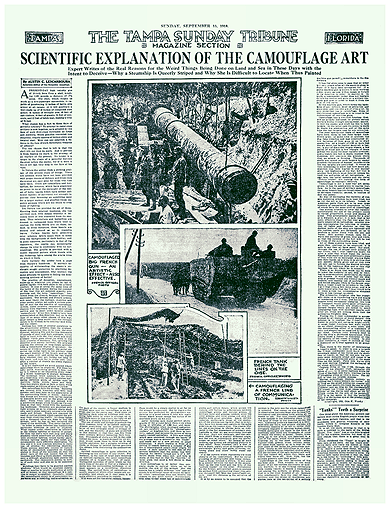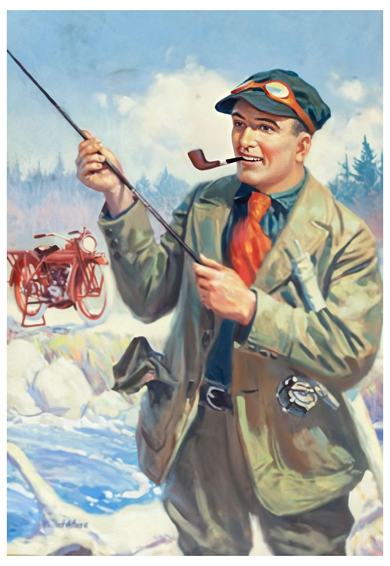 |
Antonius J. Viken, Waterloo IA / 1919
|
Above These three photographs were a reader’s contribution to Popular Mechanics, where they were published in Vol 31 Issue 2 (1919) of that magazine. The photographs were taken by A.J. Viken of Waterloo, Iowa, as examples of makeshift camouflage. Here is the text he submitted—
Practical examples of “camouflage” are shown in these three photographs. In the upper left-hand corner the man has adopted an effective, if somewhat strenuous means of making his appearance blend with his surroundings [by standing on his head, his belt line coincides with the horizon]. To the right, the small rider on the horse’s back is almost indistinguishable against the background of sky and trees, while the lower picture shows how difficult it may be to distinguish such a striking object as a goat.
A.J. Viken (Antonius Johnson Viken) [Skinderviken] was a Norwegian-American photographer. Born in Norway on October 4, 1885, he came to the US in April 1911, and became a naturalized citizen (in Chicago) in 1924. He registered for the draft on September 12, 1918, at Waterloo, where he and his wife Johanna (nee Hansen) Viken lived at 1123 Mulberry Street. As a photographer, he was employed by Louis A. Wangler at 227 East 4th Street in that city. In 1919, when his humorous camouflage photographs were published, his residence was listed as Waterloo, but in later years he also lived in Sioux City IA, Chicago, Jackson Heights NY, and on Long Island, New York. He died in Nassau NY on September 26, 1959.
Among Viken’s associates was photographer and inventor Donald Cameron Biedler (1885-1943). In 1924, both men listed their residence as 864 Buckingham Place, Chicago, in the vicinity of Wrigley Field.
Beidler was a well-known photographer of wealthy, socially prominent clients (and their children) in Chicago, and later in Manhasset, Long Island NY. Originally from Mt. Pulaski IL, Beidler was a grandson of Jabez Capps, the town's founder. In collaboration with A.J. Viken, he was also invented a special motor-driven children's portrait twin camera, called the Beidler-Viken camera (see below), which they patented in 1925. Although it consisted of two cameras, side-by-side, it was not designed to make stereoscopic images. Instead, it was operated by two photographers, one of whom maintained exact focus on the (squirming) child being photographed, while the other tripped the shutter at the opportune moment. Beidler's Chicago studio was in the Lyon and Healy Building at 64 East Jackson Boulevard, circa 1920. In 1929, he and Viken established the Beidler-Viken Studios in Manhasset on Long Island. Fourteen years later, Beidler died of a sudden heart attack, while Viken lived until 1959. In Biedler’s obituary, his partner Viken was described as “a man highly skilled in the mechanical end of photography.”
Between the years 1925 through 1936, Antonius J. Viken and Donald C. Beider worked together on a number of technical devices related to photography, including various camera stands (1925, 1930), a camera tiltback adjustment (1931), and their Beidler-Viken camera (1931). But Viken obtained patents independently for other inventions, such as a film hanger (1926), a hood for camera finders (1929), a tripod head (1931), and a film holder and hanger (1936). In 1931, Viken also worked with a bacteriologist, acetone expert, and Chicago physician named Dr. Nathaniel Frutkow (described in a research document as “a somewhat quackish physician specializing in pneumonia”) in patenting a diagnostic table and therapeutic lamp.
The following is a list, arranged by date, of some (probably not all) of the patented inventions that are attributed to Viken, Beider and Viken, or Viken and Frutkow. Full pdf patent documents can be found online by searching Google Patents.
Stand for camera and the like, 25Aug1925, w/Donald C. Beidler. Film hanger, 4May1926, 1,583,708. Hood for camera finders and the like, 26Nov1929, 1,737,038. Camera and camera stand, 14Jan1930, w/Donald C. Beidler, 1.743,184. Tripod, 10Mar1931, 1,795,747. Tiltback for cameras and the like, 17Mar1931, w/Donald C. Beidler, 1,796,315. Tripod head for portrait camera, 30Jun1931, 1,812,614. Diagnostic table, 15Sep1931, w/Nathaniel Frutkow, 1,823,534. Therapeutic Lamp, 15Sep1931, w/Nathaniel Frutkow, 1,823,535. Camera and the like, 24Nov1931, w/Donald C. Beidler, 1,833,668. Film holder and hanger, 21Jan1936, 2,028,262.




















